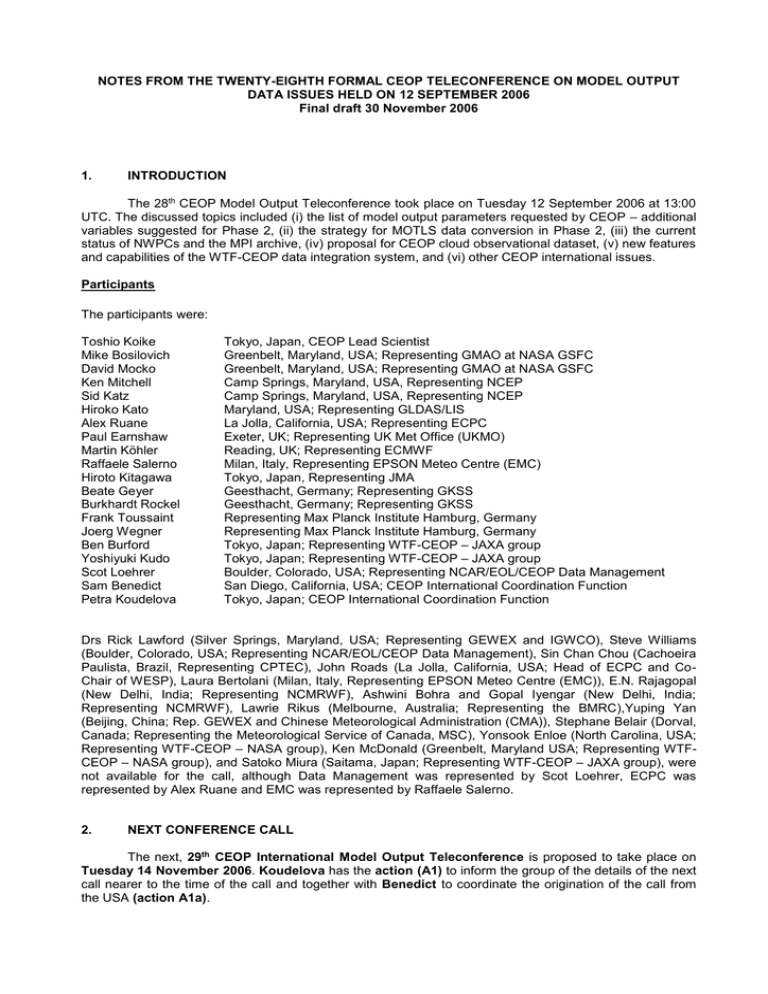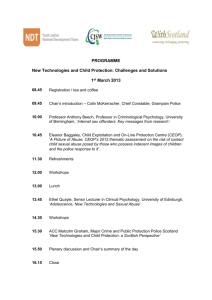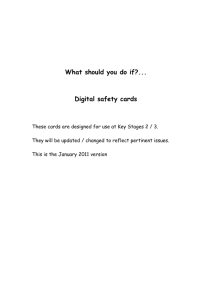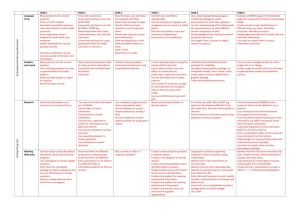NOTES FROM THE TWENTY-EIGHTH FORMAL CEOP TELECONFERENCE ON MODEL OUTPUT
advertisement

NOTES FROM THE TWENTY-EIGHTH FORMAL CEOP TELECONFERENCE ON MODEL OUTPUT DATA ISSUES HELD ON 12 SEPTEMBER 2006 Final draft 30 November 2006 1. INTRODUCTION The 28th CEOP Model Output Teleconference took place on Tuesday 12 September 2006 at 13:00 UTC. The discussed topics included (i) the list of model output parameters requested by CEOP – additional variables suggested for Phase 2, (ii) the strategy for MOTLS data conversion in Phase 2, (iii) the current status of NWPCs and the MPI archive, (iv) proposal for CEOP cloud observational dataset, (v) new features and capabilities of the WTF-CEOP data integration system, and (vi) other CEOP international issues. Participants The participants were: Toshio Koike Mike Bosilovich David Mocko Ken Mitchell Sid Katz Hiroko Kato Alex Ruane Paul Earnshaw Martin Köhler Raffaele Salerno Hiroto Kitagawa Beate Geyer Burkhardt Rockel Frank Toussaint Joerg Wegner Ben Burford Yoshiyuki Kudo Scot Loehrer Sam Benedict Petra Koudelova Tokyo, Japan, CEOP Lead Scientist Greenbelt, Maryland, USA; Representing GMAO at NASA GSFC Greenbelt, Maryland, USA; Representing GMAO at NASA GSFC Camp Springs, Maryland, USA, Representing NCEP Camp Springs, Maryland, USA, Representing NCEP Maryland, USA; Representing GLDAS/LIS La Jolla, California, USA; Representing ECPC Exeter, UK; Representing UK Met Office (UKMO) Reading, UK; Representing ECMWF Milan, Italy, Representing EPSON Meteo Centre (EMC) Tokyo, Japan, Representing JMA Geesthacht, Germany; Representing GKSS Geesthacht, Germany; Representing GKSS Representing Max Planck Institute Hamburg, Germany Representing Max Planck Institute Hamburg, Germany Tokyo, Japan; Representing WTF-CEOP – JAXA group Tokyo, Japan; Representing WTF-CEOP – JAXA group Boulder, Colorado, USA; Representing NCAR/EOL/CEOP Data Management San Diego, California, USA; CEOP International Coordination Function Tokyo, Japan; CEOP International Coordination Function Drs Rick Lawford (Silver Springs, Maryland, USA; Representing GEWEX and IGWCO), Steve Williams (Boulder, Colorado, USA; Representing NCAR/EOL/CEOP Data Management), Sin Chan Chou (Cachoeira Paulista, Brazil, Representing CPTEC), John Roads (La Jolla, California, USA; Head of ECPC and CoChair of WESP), Laura Bertolani (Milan, Italy, Representing EPSON Meteo Centre (EMC)), E.N. Rajagopal (New Delhi, India; Representing NCMRWF), Ashwini Bohra and Gopal Iyengar (New Delhi, India; Representing NCMRWF), Lawrie Rikus (Melbourne, Australia; Representing the BMRC),Yuping Yan (Beijing, China; Rep. GEWEX and Chinese Meteorological Administration (CMA)), Stephane Belair (Dorval, Canada; Representing the Meteorological Service of Canada, MSC), Yonsook Enloe (North Carolina, USA; Representing WTF-CEOP – NASA group), Ken McDonald (Greenbelt, Maryland USA; Representing WTFCEOP – NASA group), and Satoko Miura (Saitama, Japan; Representing WTF-CEOP – JAXA group), were not available for the call, although Data Management was represented by Scot Loehrer, ECPC was represented by Alex Ruane and EMC was represented by Raffaele Salerno. 2. NEXT CONFERENCE CALL The next, 29th CEOP International Model Output Teleconference is proposed to take place on Tuesday 14 November 2006. Koudelova has the action (A1) to inform the group of the details of the next call nearer to the time of the call and together with Benedict to coordinate the origination of the call from the USA (action A1a). 3. MODEL OUTPUT DATA GROUP GENERAL ISSUES 3.1 Opening (3.1a) Benedict welcomed everyone on the call and introduced the agenda as well as the reference material distributed prior to the call that included: (i) the list of newly proposed variables based on the discussion at the time of the last two calls (see ATTACHMENT 1), (ii) list of variables and their CF standard names prepared by Dr Beate Geyer (see ATTACHMENT 2), (iii), the list of model output variables selected for the West African Monsoon Model Evaluation (WAMME) provided by Dr William Lau (see ATTACHMENT 3), (iv) proposal for the CEOP cloud observational dataset drafted by Drs Martin Köhler, Michael Bosilovich, and Prof Rachel Pinker (see ATTACHMENT 4). 3.2 List of model output variables required by CEOP (3.2a) The need to revise the list of model output variables for Phase 2 was reiterated, as were the suggestions for additional variables from the last two teleconferences. In this context, the three documents related to the model output variables were referred including (i) the list of newly proposed variables based on the discussion at the time of the last two calls (see ATTACHMENT 1), (ii) list of variables and their CF standard names prepared by Dr Beate Geyer (see ATTACHMENT 2), (iii), the list of model output variables selected for the West African Monsoon Model Evaluation (WAMME) provided by Dr William Lau (see ATTACHMENT 3). The Center representatives including Bosilovich, Mocko, Roads, Ruane, Chou, Kato, Mitchell, Katz, Earnshaw, Köhler, Bertolani, Salerno, Rajagopal, Kitagawa, Belair, and Rikus, were asked to review the reference material and provide to Koudelova their suggestions for further additions or deletions to/from the current list (the document prepared by Geyer) while considering the newly proposed variables before the next call in November (action A2). These suggestions will be discussed at the time of the next call with intention to reach an agreement on the core list of the CEOP model output variables for Phase 2. (3.2b) In this context, Mitchell mentioned that it might be useful to try to standardize the frequency of the forecast output among the Centers and recommended the UK Met Office output structure as the most useful for the CEOP studies. He referred to the charts of the model data structure prepared by Frank Toussaint and Hans Luthardt and presented at one of the previous calls (see ATTACHMENT 5). Koudelova has action (A3) to circulate the referred document again and the Center representatives including Bosilovich, Mocko, Roads, Ruane, Chou, Kato, Mitchell, Katz, Köhler, Bertolani, Salerno, Rajagopal, Kitagawa, Belair, and Rikus, were asked to consider the possibility to adopt the similar pattern of the model output as the UK Met Office for Phase 2 (action A3a). 3.3 Cloud data (3.3a) Following his action from the last call, Köhler together with Michael Bosilovich and Rachel Pinker finalized and distributed a proposal for the CEOP cloud observational dataset (see ATTACHMENT 2). The document proposes to incorporate the following three subsets of cloud data into the CEOP archive to mirror the CEOP point data (MOLTS) and gridded model data: (i) CloudNet cloud profiles (point data) produced using the lidar and radar observation at several CEOP sites (Lindenberg, Cabauw, ARM SGP) for selected periods of CEOP Phase 1; the data is available in the NetCDF format; (ii) ISCCP DX total cloud cover (gridded data) of medium resolution and for a long period (complete Phase 1) including the subsets for CEOP MOLTS points; (iii) Geostationary data (gridded data) of high resolution for a short period (one month); August 2004 is recommended due to a peak of Indian monsoon activity and the North America Monsoon Experiment (NAME) timing. The effort begins with the CEOP Phase 1 data but is proposed to also continue during Phase 2. In this context, the Chilbolton observation site is proposed be accepted as the CEOP site. (3.3b) At the time of the call, it was confirmed that the cloud observational data should be incorporated into the CEOP data base. In general, the participants agreed with the introduced proposal but were asked to review the document and provide their comments and suggestions to Dr Köhler by the time of the next call (action A4). In particular, the proposed period of high-resolution gridded output (August 2004) need to be confirmed among a group based on the key science requirements. (3.3c) Koike voiced that the proposed CEOP activity would be introduced and discussed at the time of the upcoming Pan-GEWEX meeting in Frascati, Italy, 9 – 13 October 2006. 3.4 MPI status (3.4a) Toussaint reported that most of the data submitted to the MPI archive was available on-line in the raw (native) format except for the MSC and EMC inputs that were waiting in a queue for uploading. He pointed out that some issues remained with the NCMRW, GMAO, and BMRC data, which had not been submitted completely yet but Hans Luthardt was communicating these issues with the respective spokespersons. (3.4b) Toussaint further reported that they had been focusing on data reformatting into the NetCDF format and also data homogenization task. Wegner advised the group that they had converted the JMA and NCEP data into the NetCDF format using the program developed by Beate Geyer and the samples of the data had been sent to Ben Burford to assure the resulting files were suitable for the WTF-CEOP distributed data integration system. In this context, Mitchell suggested that samples of the converted MOLTS data of each center be provided back to the centers for their final assurance. Toussaint agreed to take action (A5) to advise the group when further MOLTS have been converted and send a sample to Benedict and Koudelova who will distribute it to the center spokespersons. (3.4c) Regarding the issue of MOLTS data conversion, Toussaint reported that the MPI considered doing the conversion of all of the centers’ MOTLS data during Phase 2 but more preparation was needed to confirm this decision firmly. The MPI team will report on this issue at the time of the next call. 3.5 GKSS, ICTS, and MOLTS data format issues (3.5a) Rockel reported that the table summarizing the current status of the ICTS work had been posted on the ICTS website (http://icts.gkss.de). The output of six regional models (CLM, GEM-LAM, CRCM, RCA3, RSM, C-CAM) out of eight participating had been completed for all of the 7 investigated regions for the whole 5-year period of Phase 1 (2001 – 2004) and the data of five centers has already been included into the ICTS archive where it is accessible for the ICTS partners. In the next step, the data will also be provided to the CEOP archive. (3.5b) Geyer reported that she had finished the table of variables that centers were currently providing to CEOP. She pointed out that certain variables provided by BMRC might be missing and the variables provided by NCMRWF were not included at all as the center had not submitted the MOLTS data yet. The table is available on-line: http://ksrm01.gkss.de/tmp/ceop_variables.htm and is also enclosed in ATTACHMENT 2 below. 3.6 Reference site data update by Scot Loehrer (3.6a) Loehrer introduced a detailed status of the reference site database. He took action (A6) to prepare an overview of the current data holdings at the NCAR archive within a week and send it to Koudelova, who would distribute it to the group (action A6a). Subsequently, this action has been undertaken. (3.6b) Loehrer also reiterated that the URL of the CEOP Data Management Web pages had been changed. The new address is: http://www.eol.ucar.edu/projects/ceop/dm/; where the actual status of the in-situ data holdings can be checked. 4. CURRENT STATUS OF NWPCs 4.1 JMA by Hiroto Kitagawa (4.1) Kitagawa reported that the JMA team was preparing for the data provision for Phase 2. He mentioned that the confirmation of participation of JMA in Phase 2 was in the final stage and the positive decision was expected soon. Subsequently, Kitagawa advised the CEOP Lead Scientist that the JMA administration had fully approved the JMA participation in CEOP Phase 2. 4.2 ECMWF by Martin Köhler (4.2a) Köhler reported that ECMWF had updated their model very recently, which included a new cloud scheme and an extended forecast for 15 days compare to the 10-days forecast of the former prediction system. (4.2b) Köhler further reported that they continued submitting of the Phase 1 data and would complete the task in the near future. He also pointed out that they were anticipating the list of the MOLTS points for Phase 2. 4.3 ECPC by Alex Ruane (4.3a) Ruane reiterated that the ECPC team had provided to the MPI archive two outputs of their global model (operation and reanalysis) for the whole Phase 1 period and also the output of their regional model that was run over the land covers. All of these data sets are available at the MPI database. (4.3b) Ruane further mentioned that users should aware of several points that could be found in the online metadata documentation. In particular, the users should check whether they are using the accumulated or instantaneous values and in case of accumulated values of 3-hourly forecast output they should be aware that the accumulated value is the average value of that variable of over the 3-hourly period preceding the forecast time. Ruane voiced that this output might be confusing and not essential for the CEOP analyses and thus they might not include these (accumulated) values in the output for CEOP in Phase 2. (4.3c) Ruane further reported that they were analyzing their CEOP Phase 1 data and also starting with intercomparison analyses. 4.4 GMAO by Mike Bosilovich (4.4a) Bosilovich mentioned that the comparisons published in the latest (10th) issue of the CEOP Newsletter, had been produced remotely using a Grads Data Server (GDS) as the source for the data. He pointed out that in an effort to show the utility of this approach the scripts and instructions to use them were made available for download at ftp://gmaoftp.gsfc.nasa.gov/pub/data/mikeb/CEOP/NAME_example.zip. People can reproduce these intercomparisons by running the referred scripts from their computers using Grads, Ferret, MatLab, or IDL. Earnshaw mentioned that he had followed up the said exercise and found it very interesting. (4.4b) Bosilovich further reiterated that they were finishing the testing of the new version of their model and were beginning to focus on intercomparison of their model and other models contributing to CEOP. The analyses of the first results by the new system will be presented at the AGU Fall Meeting in San Francisco in December 2006. (4.4c) Bosilovich voiced that he would be interested in the MOTLS data of different centers that had been converted by the MPI team. (4.4d) Bosilovich also mentioned that they were working with the CEOP in-situ data available for EOP-3 and EOP4 period and converted and processed them for the purpose of their intercomparison studies. He pointed out that they would be happy to share the tools and resulting files with other users. 4.5 GLDAS by Hiroko Kato (4.5a) Kato mentioned that the description of the previously submitted GLDAS data was available in the latest issue of the CEOP Newsletter. The CEOP Newsletter is available on-line through the CEOP Home Page at: http://monsoon.t.u-tokyo.ac.jp/ceop/newsletter/CEOP_NEWS_10.pdf. (4.5b) Kato further reported that they were working on multiple analyses of a long-term (27 years) output and of the data, which should be used to force the simulation. The goal is to find trends in the simulation and to identify the effect of use of new observation-based precipitation and radiation fields as the forcings in recent years. In addition, an analysis of the use of different source precipitation products as the forcing data is being carried out. 4.6 NCEP by Ken Mitchell (4.6a) Mitchell reiterated that they were preparing software for providing the NCEP MOLTS files in the NetCDF format and for that purpose the NCEP Phase 1 MOLTS files converted by the MPI team would be very helpful. (4.6b) Mitchell further reported that NCEP would implement a major upgrade of the objective analysis scheme in February 2007 and thus they considered to begin with Phase 2 contribution in February 2007. 4.7 EPSON Meteo Centre (EMC) by Laura Bertolani and Raffaele Salerno (4.7a) Salerno reiterated that they had provided a sample of the MOLTS output to the MPI archive and were preparing a sample of the gridded data that might be transferred to the MPI by the end of September. The transfer of the operational data will begin in January 2007. 4.8 UK Met Office by Paul Earnshaw (4.8a) Earnshaw reiterated that the small error in a certain portion of their MOLTS that had been reported at the time of the 26th call had been corrected and the data had been sent to the MPI archive. 5. DATA INTEGRATION ISSUES 5.1 WTF-CEOP – JAXA group and on-line demonstration of the system (5.1a) Burford reported that they had updated their software to solve the issues that were emerging when other browsers than Microsoft Explorer were used to work with the WTF-CEOP system. The participants who are using different browsers confirmed that since the update they could access and use the WRFCEOP system without any difficulties. (5.1b) Burford further mentioned that new features had been introduced on the system that included possibility of plotting vertical profiles and overlaying two datasets in a single chart. (5.1c) The new features enabling quick comparison of MOLTS data were planned to be introduced during the on-line demo. However, due to certain technical issues, the demo could not be completed and was postponed for the next call. 6. OTHER ISSUES (6a) Koike informed the participants that the next, 6th CEOP International Implementation Planning Meeting would be held in Washington D.C., USA, 12 – 14 March 2007 and would be followed by the IGWCO planning meeting (14 – 17 March 2007) with a CEOP/IGWCO joint session on 14 March 2007, afternoon. The announcement and invitation letter with more details will be sent to the CEOP community in the near future. (6b) Loehrer reiterated that the URL of the CEOP Data Management Web pages had been changed. The new address is: http://www.eol.ucar.edu/projects/ceop/dm/. (6c) The 10th issue of the CEOP Newsletter was published at the end of August and made available on-line through the CEOP Home Page at: http://monsoon.t.u-tokyo.ac.jp/ceop/newsletter/CEOP_NEWS_10.pdf. (6d) It was reiterated that the Pan-GEWEX meeting would be held in Frascati, Italy, 9 – 13 October 2006. The achievements of CEOP Phase 1 will be assessed at this meeting and the members of the CEOP Model Output group were acknowledged for their special efforts and excellent contributions they have been providing on behalf of CEOP throughout Phase 1 and beyond that have led to the successful outcome of the CEOP Model Output group. (6e) Koudelova reported that the CEOP session proposed for the 2006 AGU Fall Meeting had received 23 contributions in total and acknowledged all the contributors. The AGU Fall Meeting will take place in San Francisco, CA, USA, from 11 through 15 December 2006. 7. CLOSING Koike acknowledged the participants for attending the call and providing their valuable contributions, comments and suggestions. The call was adjourned at 15:00 UTC. ATTACHMENT 1 List of newly proposed variables (26th and 27th call) ATTACHMENT 2 List of CEOP variables – CF standard names ATTACHMENT 3 List of model output variables selected for the West African Monsoon Model Evaluation (WAMME) project ATTACHMENT 4 Proposal for the CEOP cloud observational dataset ATTACHMENT 5 CEOP Model Data Structure (by F. Toussaint/H. Luthardt)







